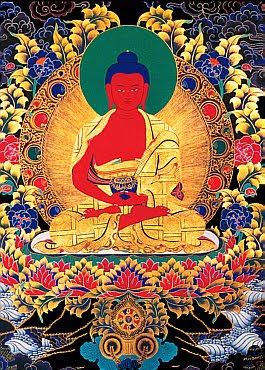
By Andrew Olendzki
Imagine what would happen if you took six lengths of rope and tied one end of each to six creatures: a snake, a crocodile, a bird, a dog, a jackal, and a monkey. Then tie the other end of all these into a big knot and let go. What do you think would happen? Each of these animals would pull in a different direction, trying to return to their favorite haunts. The snake would slither toward its nest in the anthill, the crocodile would pull for the river, the bird would fly up into the air, the dog would head to the village, the jackal to the charnel ground, and the monkey would scamper for the trees. Can you picture such a scene?
The Buddha tells this story in the Samyutta Nikaya (35.247) to illustrate the state of the undisciplined mind, wherein each of the six senses (eye, ear, nose, tongue, body, and mind) is drawn to its own domain and to its customary feeding grounds in the pursuit of pleasure. He describes this situation as dwelling with a limited mind, wherein a person has no freedom whatsoever. The solution he offers is to drive a stake through the central knot into the ground, thus binding all six animals to the spot. The stake represents mindfulness of the body, and it is the means of attaining freedom.
How can this be? Surely this turns our ordinary notion of freedom on its head and offers something thoroughly counterintuitive, if not downright paradoxical. Usually we consider ourselves free only when we can do what we want, and we would consider being tethered to a post the worst kind of bondage. But let’s look at the image a bit more closely and try to figure out what the Buddha has in mind here.
Each of these six creatures thinks it’s free if it can go where it wants, but in fact each is bound in several ways. First, it is compelled by instinct to pursue pleasure and avoid pain; next, it generally only knows to seek its gratification in accustomed places; and finally, it can only make headway toward its desired object if it gains a temporary advantage in the tug-of-war with the others. Before long each animal will expend its energy in the struggle, and will eventually be dragged around by whichever is the strongest. (My money is on the crocodile.)
The six senses of the human mind and body are bound by an internal constraint more compelling than any rope or stake, insofar as they will always pull in the direction of agreeable objects and away from disagreeable objects. From the Buddha’s perspective, the freedom to act on compulsion is an illusory sense of freedom concocted by a constricted and profoundly deluded mind. It’s a bit like telling an addict she is free to stop using drugs if she wants, or like telling an inmate of an island prison he should feel free to go anywhere on the island he chooses.
Mindfulness practice offers the restraint necessary to overcome the tug of desire upon the senses. As we notice the mind wandering off to explore a gratifying train of thought, or as we notice the body’s urging to nudge ourselves into a more comfortable position, we gently abandon the impulse and return attention to the primary object of awareness. We do this again and again, until the mind becomes content with being fully present with what is manifesting here and now in the field of experience, rather than rushing off for some other form of stimulation. As the mind settles down it becomes considerably more powerful, and thus more empowered.
The story told by the Buddha ends in a lovely picture of all six animals lying down contentedly in one another’s company, no longer exerting themselves, no longer yearning for something else. Similarly, when the tug of sense desire and aversion has been quieted, when restlessness and sluggishness have been balanced out, and when doubts are put aside for a time, the mind is able to attend to experience more openly and with much greater freedom. With the senses no longer struggling to reach pleasing forms and no longer regarding unpleasing forms as repulsive, the mind is able to see more clearly what is actually arising and falling away.
In this mode the mind is said to be unlimited, and to be capable of experiencing a greater freedom through wisdom. Its freedom comes not from the license to broadly explore a shallow terrain, defined by its likes and dislikes, but rather from the ability to shake off the constraints of desire altogether and plunge deeply into investigating the field of experience as it is. It turns out that what one sees, hears, smells, tastes, touches, or thinks is not as important as how one does so.
We are used to thinking of freedom as being free to do what we want, but the Buddha sees it as being free from wanting. We tend to think of the post as the fetter and freedom as the ability to obtain agreeable objects of sense. The Buddha considers the pursuit of pleasure to be the fetter, while the mindfulness post represents our chance to break free of its bonds. This is indeed a different way of thinking of things; but perhaps he is pointing to something worth investigating. Perhaps internal freedom is ultimately more valuable than external freedom.
Andrew Olendzki, Ph.D., is the executive director of the Barre Center for Buddhist Studies in Barre, Massachusetts. He is the editor of Insight Journal.
















.jpg)


















